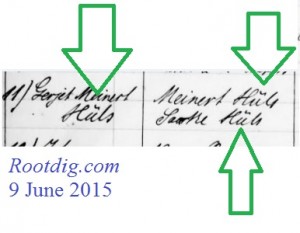Jim Biedler gently asked me about the spelling of “Huls” in my previous post on an 1891 marriage record involving a bride and groom who shared the same last name both before and after their marriage. In my original posting, the spelling “Huls” was used throughout the post. There was a problem with that.
1891 marriage record involving a bride and groom who shared the same last name both before and after their marriage. In my original posting, the spelling “Huls” was used throughout the post. There was a problem with that.
The marriage record did not say “Huls.”
It said “Hüls” or, appropriately transcribed without the umlaut, “Huels.”
In some written records on this family early in their time in the United States, the non-umlaut version of “Huels” is used. However at some point in time this family dropped the “e” and the umlaut and simply went with Huls and the vast majority of records on this family in the United States use that spelling. For that reason, I’ve standardized the spelling to Huls when writing about the family or commenting on a record and interpreting it.
However document transcription requires a greater attention to detail and an eye for transcribing the document how it is written.
I’m not certain what the BCG Standards Manual has to say about transcribing documents with diacritics, but I’m reasonably certain the intent of transcription is to render the document faithfully. That’s probably stated explicitly or implied somewhere in the Standards Manual. I’m fairly certain that Evidence Explained suggests that transcriptions be done faithfully to the original as well.
The transcription of a document is different from a discussion of a family and writing about conclusions regarding various family members. In those writings I’ll use the spelling of “Huls” as that’s what the family used.
Jim Biedler’s book on German research (The Family Tree German Genealogy Guide) is one that I have on my shelf. I don’t remember what he says about umlauts.
Note: the original post has been edited so that the correct transcription is used in the summary of the document.

No responses yet